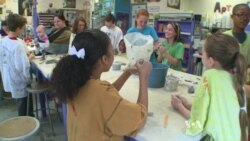Two years ago, when Maryland schoolgirl Miriam Gardsbane turned nine, her aunt — who lives in Kenya — 'adopted' an elephant in her name as a birthday gift. Miriam and her mother visited Africa to see how that donation was helping to support elephants, and Miriam fell in love with the animals.
A few months later, she watched How I Became an Elephant, a documentary about the mistreatment of elephants in Thailand, and a young girl's campaign to save them.
Miriam was inspired to launch her own effort to raise awareness and money to save elephants.
According to the documentary, produced by Tim Gorski, elephants in Thailand are systematically tortured.
“Elephants go there in a system we call it ‘crushing’ because it’s supposed to crush their soul,” Miriam explained. “They take the baby elephant; they put it in this very small cage.
"They don’t give it food or water for a lot of days and like beat it with nails and hooks and they [elephants] are really struggling, trying to get out. They don’t let them. Some elephants just collapse. And when they stop struggling that means its soul is crushed,” she explained.
Soul-crushing imprisonment
Crushing the soul is a turning point in the elephants’ life. "Basically the trainer is saying I’m your boss. You’re not going to the wild life. I’m just going to take over your life,” said Miriam.
As the girl in the documentary did, Miriam decided to raise money for Lek Chailert, the animal activist who runs Elephant Nature Park www.elephantnaturepark.org, a sanctuary for elephants rescued from Thailand's tourist and illegal logging industries.
“I hope that I create awareness so that a lot of people know they shouldn’t do this,” Miriam said. “Then, it might get banned."
Miriam founded “They Deserve To Be Free” and got her friends involved. She asked them to donate to Elephant Nature Park instead of buying her birthday gifts. She ran a bake sale and made posters with information about elephant abuse. And she came up with the idea of making and selling clay elephants.
That last project received help from her art teacher, Kate Santorineos. Miriam said, “She helped me make all these elephants. She taught me a lot of things about art and I made a bunch of elephants, me and my friends, and we glazed them.”
Elephants gain support
Santorineos opened her art studio to Miriam and her friends on weekends and during the school's spring recess to work on the project. She even donated the clay.
“To have a young student interested in spending her time, instead of going to the mall or shopping or watching TV or playing games, but wanting to spend her time for another cause is what we all should aspire to,” said Santorineos. “And so I was very excited to try to find ways to make it happen.”
She added that the youngsters are learning many lessons beyond how to sculpt an elephant.
“It’s very difficult to take a round piece of clay, a blob and to pull the shape out of the clay and envision an animal within the blob. But these kids are learning about elephants. They are learning about Thailand. They are learning about ivory trade,” she said.
Living with elephants
Miriam also has the wholehearted support of her mother, veterinarian Arlene Gardsbane.
“She wants to make sure that she is educating people as to what’s happened to elephants,” Gardsbane said of her daughter. "I think what it is doing is making her a little bit mature. She knows a lot about what she’s doing. She knows a lot about what’s going on with animals, with people."
They visited Kenya and Thailand, so Miriam could see the situation for herself, and spend weeks helping care for elephants in the sanctuaries.
“When we went to Thailand," Miriam recalled, "the woman who runs the Elephant Nature Park, her name is Lek Chailert, she wanted me to go in the jungle and see the elephants. It was just me and two other volunteers and my Mom. We went into the jungle and saw the elephants in their natural habitat. She invited me to a school to educate kids in Thailand about the cause. I made a lot of Thai friends.”
Being able to do something to help elephants, Miriam said, makes her proud and happy. “We’ve sold about 180 [clay] elephants,” she reported. “Last year we made like $2,000 and sent all the $2,000 to the Elephant Nature Park.”
In the coming months, Miriam and her friends are planning to sell their clay elephants at a local Farmers Market, hoping to raise more money and awareness because, as Miriam said, elephants deserve to be free.
Farmers Markets like this one in Olney, Maryland, thrive in many U.S. communities. People come here to buy food of all kinds directly from the farmers.
Also available for sale, the work of local artists.. like the small, clay elephants.
But each little elephant sold can make a big difference in a pachyderm's future; proceeds go directly to the Elephant Nature Park in Thailand.
They made more than 100 — a mixture of elephants and tiles with elephants on them.












